Green Synthesis and Efficient Adsorption: Na-X Zeolite vs. C/Mn/SiO2 Composite for Heavy Metals Removal
Abstract
1. Introduction
2. Materials and Methods
3. Results
3.1. Characteristics of Na-X Zeolite and C/Mn/SiO2 Composite
3.2. Comparison of Adsorption/Desorption of Heavy Metal Ions on the Na-X Zeolite and the C/Mn/SiO2 Composite in the Single and Mixed Adsorbate Systems
3.3. Comparative Electrokinetic Studies
3.4. Comparison of Stability of the Zeolite and Composite Suspensions
4. Conclusions
Author Contributions
Funding
Institutional Review Board Statement
Informed Consent Statement
Data Availability Statement
Conflicts of Interest
References
- Sweety, P. Impacts of Soil Pollution on Environment. NVEO Nat. Volatiles Essent. Oils J. 2021, 85, 3314–3320. [Google Scholar]
- Food and Agriculture Organization of the United States. Global Assessment of Soil Pollution; Food and Agriculture Organization of the United States: Rome, Italy, 2021; p. 846. [Google Scholar]
- Ghaffar, I.; Javid, A.; Bukhari, S.M.; Ali, W.; Hashmi, S.G.M.D.; Hussain, A. Nano- and Microplastics in the Environment: A Potential Threat to in-Situ Bioremediation of Wastewaters. In Waste Management and Resource Recycling in the Developing World; Elsevier: Amsterdam, The Netherlands, 2023; pp. 417–436. [Google Scholar]
- Wang, Y.; Li, H.; Lin, S. Advances in the Study of Heavy Metal Adsorption from Water and Soil by Modified Biochar. Water 2022, 14, 3894. [Google Scholar] [CrossRef]
- Fei, Y.; Hu, Y.H. Recent Progress in Removal of Heavy Metals from Wastewater: A Comprehensive Review. Chemosphere 2023, 335, 139077. [Google Scholar] [CrossRef] [PubMed]
- Sarti, E.; Chenet, T.; Stevanin, C.; Costa, V.; Cavazzini, A.; Catani, M.; Martucci, A.; Precisvalle, N.; Beltrami, G.; Pasti, L. High-Silica Zeolites as Sorbent Media for Adsorption and Pre-Concentration of Pharmaceuticals in Aqueous Solutions. Molecules 2020, 25, 3331. [Google Scholar] [CrossRef]
- Sabzehmeidani, M.M.; Mahnaee, S.; Ghaedi, M.; Heidari, H.; Roy, V.A.L. Carbon Based Materials: A Review of Adsorbents for Inorganic and Organic Compounds. Mater. Adv. 2021, 2, 598–627. [Google Scholar] [CrossRef]
- Mokrzycki, J.; Franus, W.; Panek, R.; Sobczyk, M.; Rusiniak, P.; Szerement, J.; Jarosz, R.; Marcińska-Mazur, L.; Bajda, T.; Mierzwa-Hersztek, M. Zeolite Composite Materials from Fly Ash: An Assessment of Physicochemical and Adsorption Properties. Materials 2023, 16, 2142. [Google Scholar] [CrossRef]
- Szerement, J.; Szatanik-Kloc, A.; Jarosz, R.; Bajda, T.; Mierzwa-Hersztek, M. Contemporary Applications of Natural and Synthetic Zeolites from Fly Ash in Agriculture and Environmental Protection. J. Clean. Prod. 2021, 311, 127461. [Google Scholar] [CrossRef]
- Medykowska, M.; Wiśniewska, M.; Szewczuk-Karpisz, K.; Panek, R.; Franus, M. Simultaneous Removal of Inorganic and Organic Pollutants from Multicomponent Solutions by the Use of Zeolitic Materials Obtained from Fly Ash Waste. Clean Technol. Environ. Policy 2023, 25, 1133–1148. [Google Scholar] [CrossRef]
- Soudejani, H.T.; Kazemian, H.; Inglezakis, V.J.; Zorpas, A.A. Application of Zeolites in Organic Waste Composting: A Review. Biocatal. Agric. Biotechnol. 2019, 22, 101396. [Google Scholar] [CrossRef]
- Panek, R.; Madej, J.; Bandura, L.; Słowik, G. Recycling of Waste Solution after Hydrothermal Conversion of Fly Ash on a Semi-Technical Scale for Zeolite Synthesis. Materials 2021, 14, 1413. [Google Scholar] [CrossRef] [PubMed]
- Sádovská, G.; Honcová, P.; Morávková, J.; Jirka, I.; Vorokhta, M.; Pilař, R.; Rathouský, J.; Kaucký, D.; Mikysková, E.; Sazama, P. The Thermal Stability of Carbon Materials in the Air: Quantitative Structural Investigation of Thermal Stability of Carbon Materials in Air. Carbon 2023, 206, 211–225. [Google Scholar] [CrossRef]
- Sai Bhargava Reddy, M.; Ponnamma, D.; Sadasivuni, K.K.; Kumar, B.; Abdullah, A.M. Carbon Dioxide Adsorption Based on Porous Materials. RSC Adv. 2021, 11, 12658–12681. [Google Scholar] [CrossRef]
- Murtaza, G.; Ahmed, Z.; Eldin, S.M.; Ali, I.; Usman, M.; Iqbal, R.; Rizwan, M.; Abdel-Hameed, U.K.; Haider, A.A.; Tariq, A. Biochar as a Green Sorbent for Remediation of Polluted Soils and Associated Toxicity Risks: A Critical Review. Separations 2023, 10, 197. [Google Scholar] [CrossRef]
- Moynier, F.; Pichat, S.; Pons, M.-L.; Fike, D.; Balter, V.; Albarède, F. Isotopic Fractionation and Transport Mechanisms of Zn in Plants. Chem. Geol. 2009, 267, 125–130. [Google Scholar] [CrossRef]
- Liu, J.; Dong, Y.; Xu, H.; Wang, D.; Xu, J. Accumulation of Cd, Pb and Zn by 19 Wetland Plant Species in Constructed Wetland. J. Hazard. Mater. 2007, 147, 947–953. [Google Scholar] [CrossRef]
- Zhang, Y.; Geißen, S.-U.; Gal, C. Carbamazepine and Diclofenac: Removal in Wastewater Treatment Plants and Occurrence in Water Bodies. Chemosphere 2008, 73, 1151–1161. [Google Scholar] [CrossRef]
- Medykowska, M.; Wiśniewska, M.; Galaburda, M.; Szewczuk-Karpisz, K. Novel Carbon-Based Composites Enriched with Fe and Mn as Effective and Eco-Friendly Adsorbents of Heavy Metals in Multicomponent Solutions. Chemosphere 2023, 340, 139958. [Google Scholar] [CrossRef]
- Jodeh, S.; Abdelwahab, F.; Jaradat, N.; Warad, I.; Jodeh, W. Adsorption of Diclofenac from Aqueous Solution Using Cyclamen Persicum Tubers Based Activated Carbon (CTAC). J. Assoc. Arab Univ. Basic Appl. Sci. 2016, 20, 32–38. [Google Scholar] [CrossRef]
- Janusz, W. Electrical double layer at the metal oxide–electrolyte interface in “interfacial forces and fields: Theory and applications”. In Surfactant Science; Marcel Dekker: New York, NY, USA, 1999; Volume 85, Chapter 4. [Google Scholar]
- Kunecki, P.; Panek, R.; Wdowin, M.; Bień, T.; Franus, W. Influence of the Fly Ash Fraction after Grinding Process on the Hydrothermal Synthesis Efficiency of Na-A, Na-P1, Na-X and Sodalite Zeolite Types. Int. J. Coal Sci. Technol. 2021, 8, 291–311. [Google Scholar] [CrossRef]
- Neimark, A.V.; Ravikovitch, P.I.; Vishnyakov, A. Adsorption Hysteresis in Nanopores. Phys. Rev. E 2000, 62, R1493–R1496. [Google Scholar] [CrossRef]
- Luan, L.; Tang, B.; Ma, S.; Sun, L.; Xu, W.; Wang, A.; Niu, Y. Removal of aqueous Zn(II) and Ni(II) by Schiff base functionalized PAMAM dendrimer/silica hybrid materials. J. Mol. Liq. 2021, 330, 115634N. [Google Scholar] [CrossRef]
- Wiśniewska, M.; Nowicki, P.; Szewczuk-Karpisz, K.; Gęca, M.; Jędruchniewicz, K.; Oleszczuk, P. Simultaneous removal of toxic Pb(II) ions, poly(acrylic acid) and Triton X-100 from their mixed solution using engineered biochars obtained from horsetail herb precursor—Impact of post-activation treatment. Sep. Purif. Technol. 2021, 276, e119297. [Google Scholar] [CrossRef]
- Liang, T.; Li, L.; Zhu, C.; Liu, X.; Li, H.; Su, Q.; Ye, J.; Geng, B.; Tian, Y.; Sardar, M.F.; et al. Adsorption of As(V) by the novel and efficient adsorbent cerium-manganese modified biochar. Water 2020, 12, 2720. [Google Scholar] [CrossRef]
- Skwarek, E.; Janusz, W.; Sternik, D. Adsorption of citrate ions on hydroxyapatite synthetized by various methods. J. Radioanal. Nucl. Chem. 2013, 299, 2027–2036. [Google Scholar] [CrossRef]
- Visa, M. Synthesis and Characterization of New Zeolite Materials Obtained from Fly Ash for Heavy Metals Removal in Advanced Wastewater Treatment. Powder Technol. 2016, 294, 338–347. [Google Scholar] [CrossRef]
- Usman, M.; Ahmed, A.; Ji, Z.; Yu, B.; Shen, Y.; Cong, H. Environmentally Friendly Fabrication of New β-Cyclodextrin/ZrO2 Nanocomposite for Simultaneous Removal of Pb(II) and BPA from Water. Sci. Tot. Environ. 2021, 784, 147207. [Google Scholar] [CrossRef]
- Lin, Z.; Weng, X.; Owens, G.; Chen, Z. Simultaneous Removal of Pb(II) and Rifampicin from Wastewater by Iron Nanoparticles Synthesized by a Tea Extract. J. Clean Prod. 2020, 242, 118476. [Google Scholar] [CrossRef]
- Wang, G.; Xiao, H.; Zhu, J.; Zhao, H.; Liu, K.; Ma, S.; Zhang, S.; Komarneni, S. Simultaneous Removal of Zn2+ and P-Nitrophenol from Wastewater Using Nanocomposites of Montmorillonite with Alkyl-Ammonium and Complexant. Environ. Res. 2021, 201, 111496. [Google Scholar] [CrossRef]
- Zhang, H.; Li, R.; Zhang, Z. A Versatile EDTA and Chitosan Bi-Functionalized Magnetic Bamboo Biochar for Simultaneous Removal of Methyl Orange and Heavy Metals from Complex Wastewater. Environ. Pollut. 2022, 293, 118517. [Google Scholar] [CrossRef]
- Bąk, J. Comparison of Sorption Capacity of Biochar-Based Sorbents for Capturing Heavy-Metallic Ions from Water Media. Physicochem. Probl. Miner. 2022, 58, 150265. [Google Scholar] [CrossRef]
- Soria, R.I.; Rolfe, S.A.; Betancourth, M.P.; Thornton, S.F. The Relationship between Properties of Plant-Based Biochars and Sorption of Cd(II), Pb(II) and Zn(II) in Soil Model Systems. Heliyon 2020, 6, e05388. [Google Scholar] [CrossRef]
- Fijałkowska, G.; Szewczuk-Karpisz, K.; Wiśniewska, K. Ionic Polyacrylamides as Stability-Modifying Substances of Soil Mineral Suspensions Containing Heavy Metal Impurities. Int. J. Environ. Sci. Technol. 2020, 17, 1101–1112. [Google Scholar] [CrossRef]
- M’Pandou, A.; Siffert, B. Polyethyleneglycol adsorption at the TiO2-H2O Interface: Distortion of ionic structure and shear plane position. Colloids Surf A 1987, 4, 159–172. [Google Scholar] [CrossRef]
- Gelardi, G.; Flatt, R.J. Working mechanisms of water reducers and superplasticizers. In Science and Technology of Concrete Admixtures; Flatt, R., Ed.; Woodhead Publishing: New York, NY, USA, 2016; pp. 257–278. [Google Scholar]


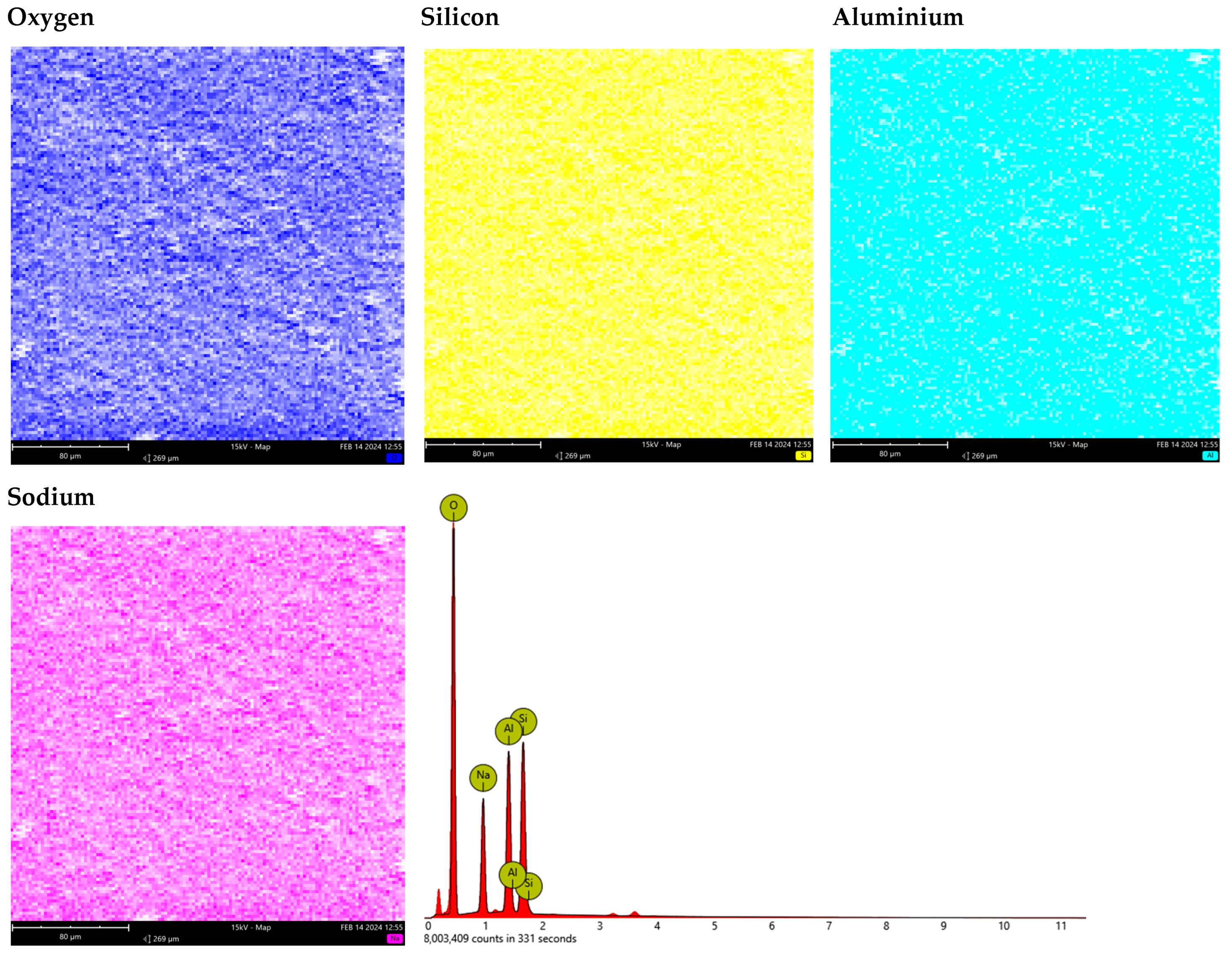
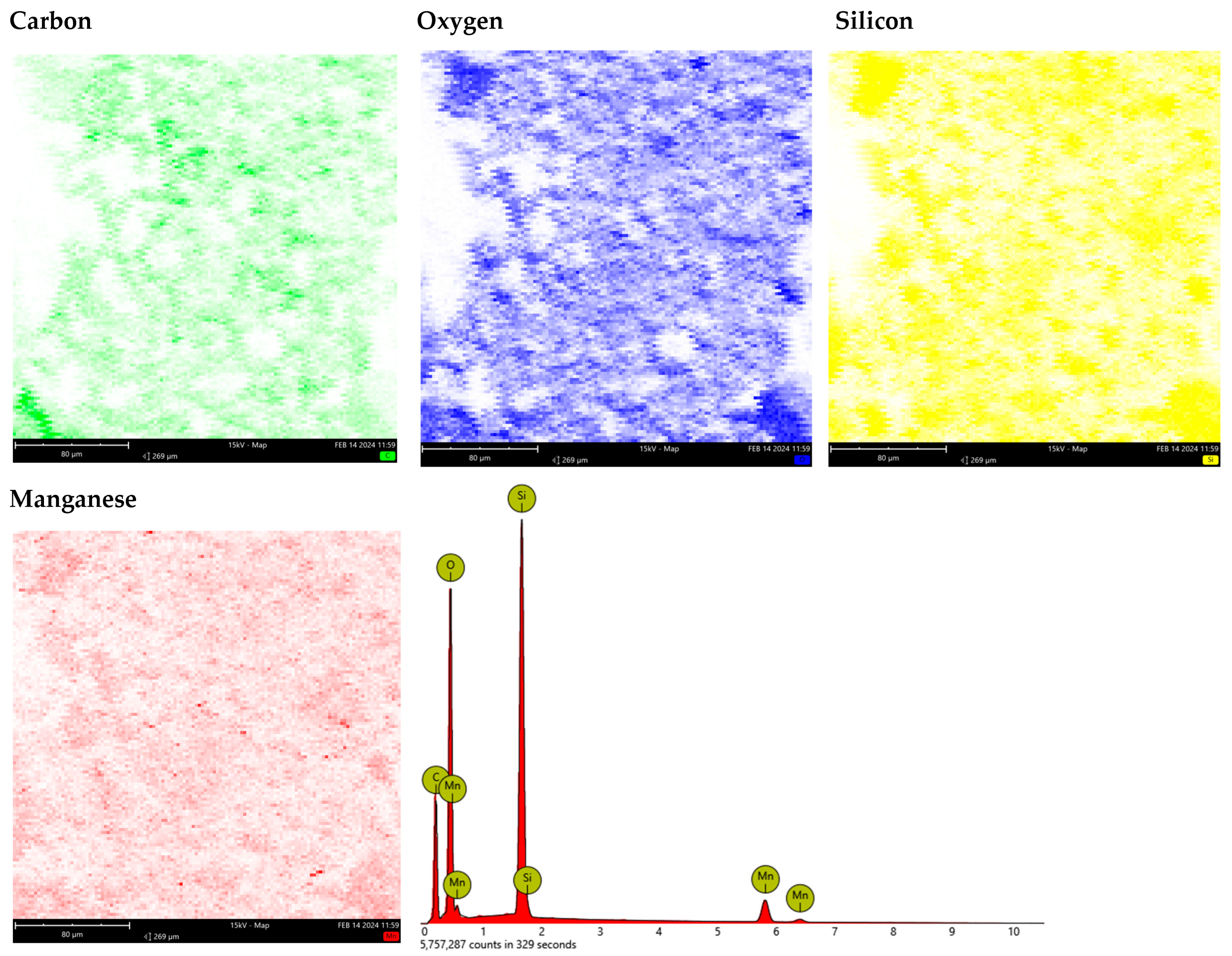
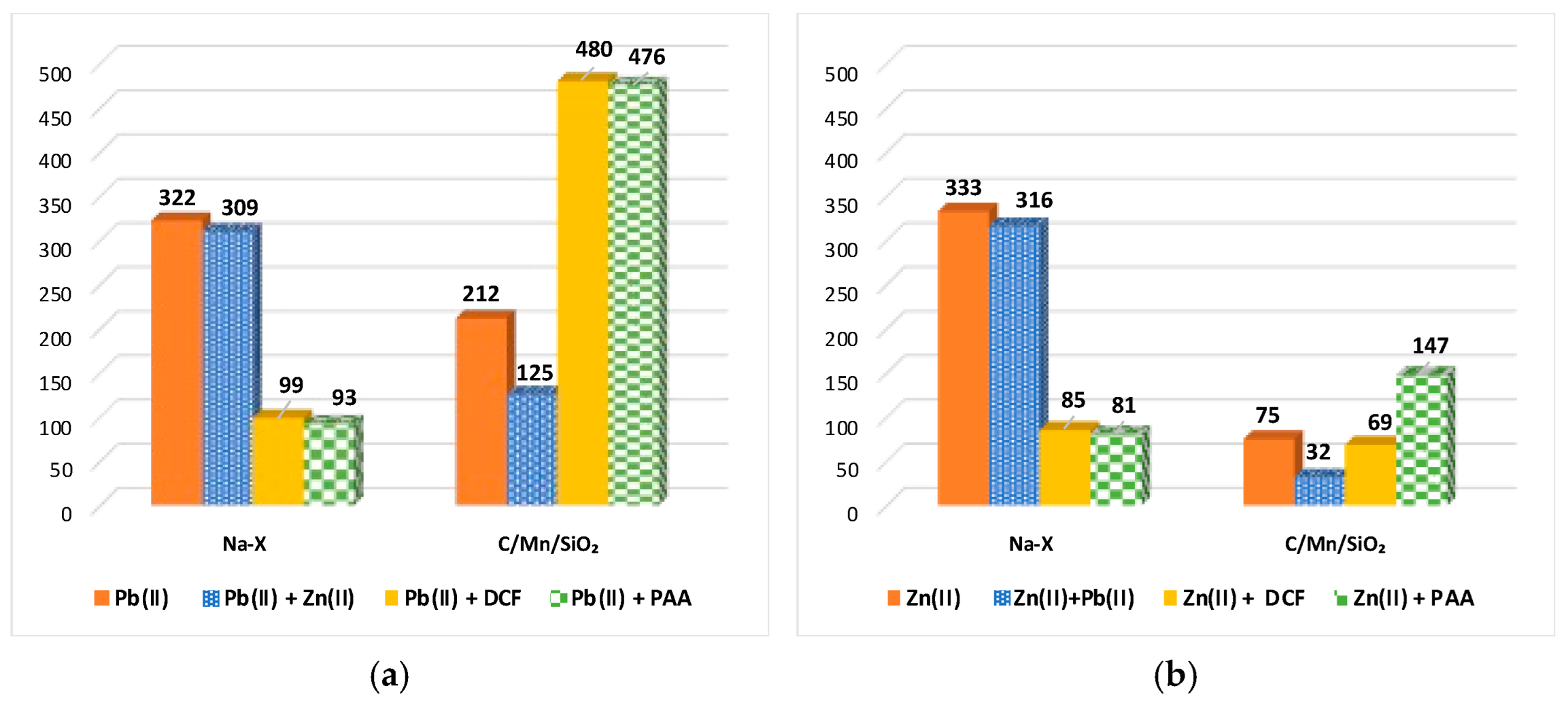
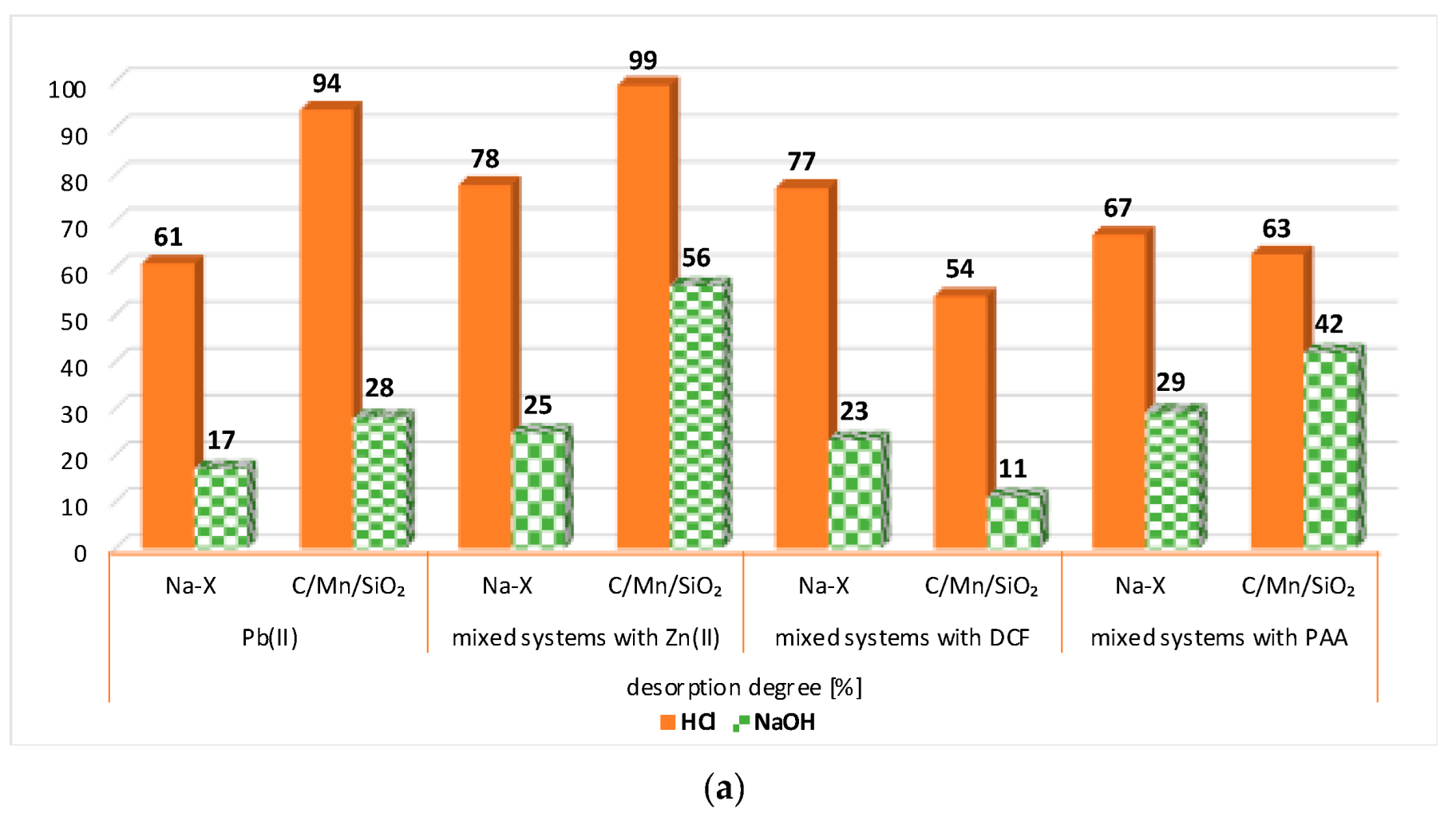
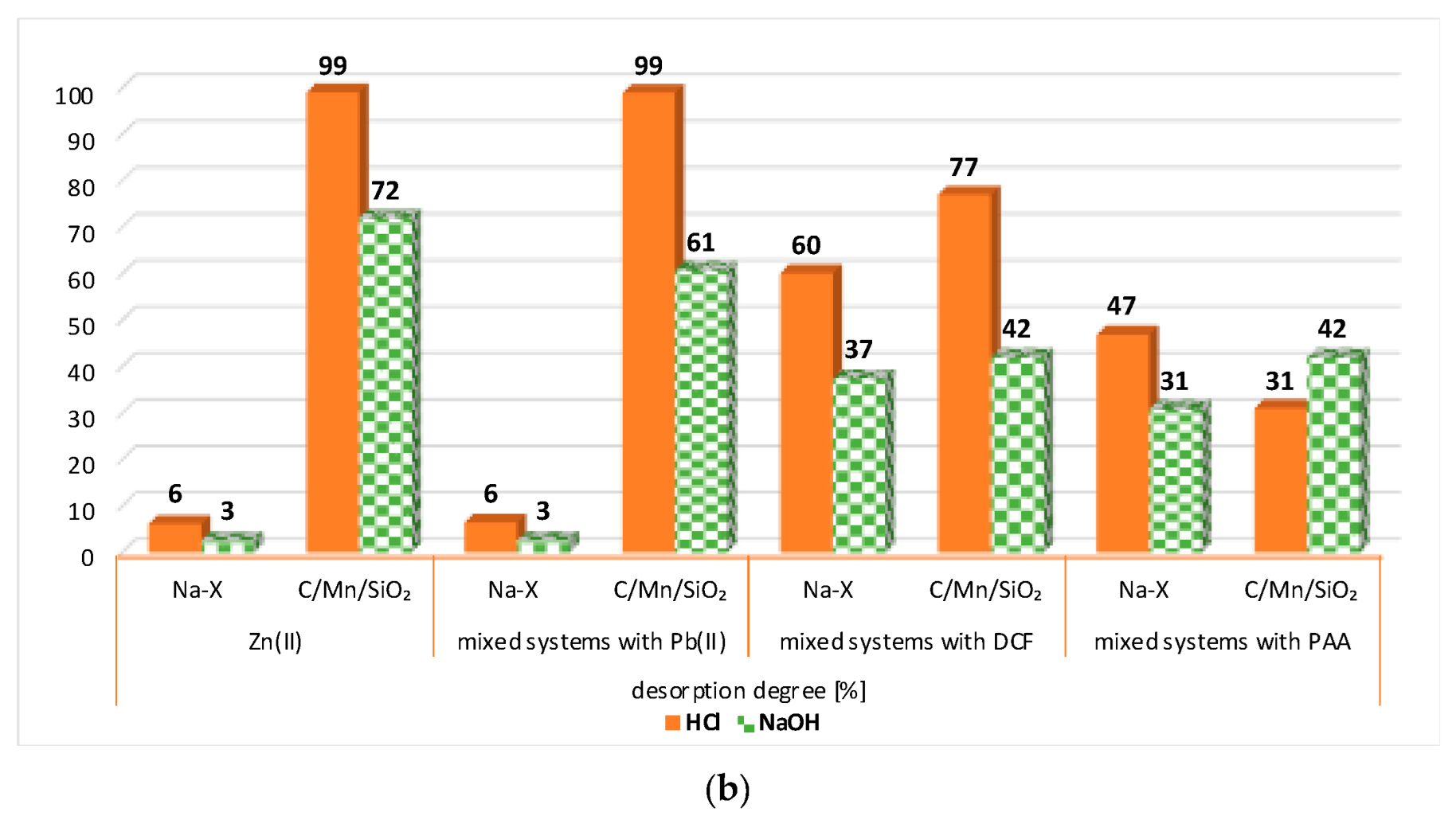
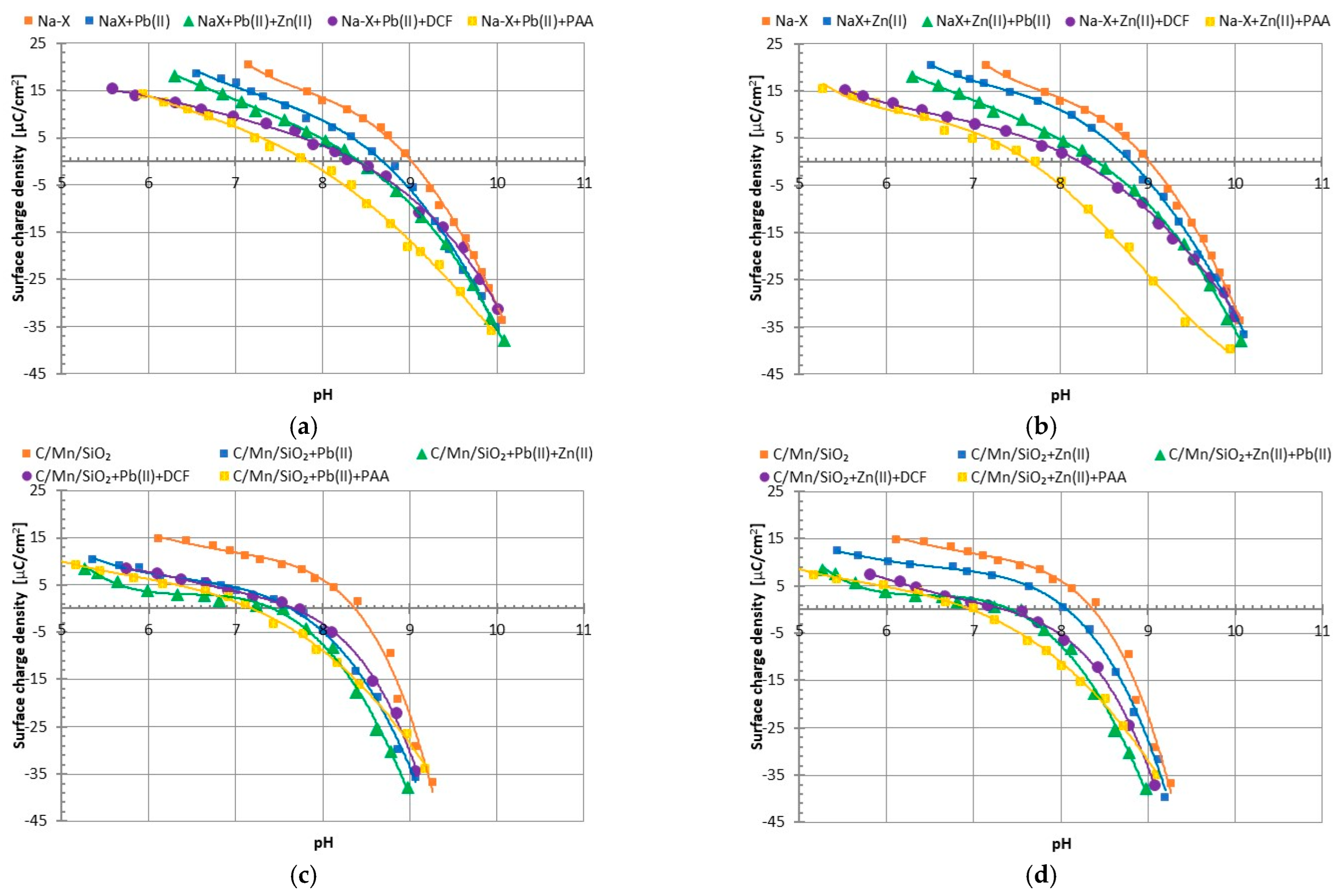
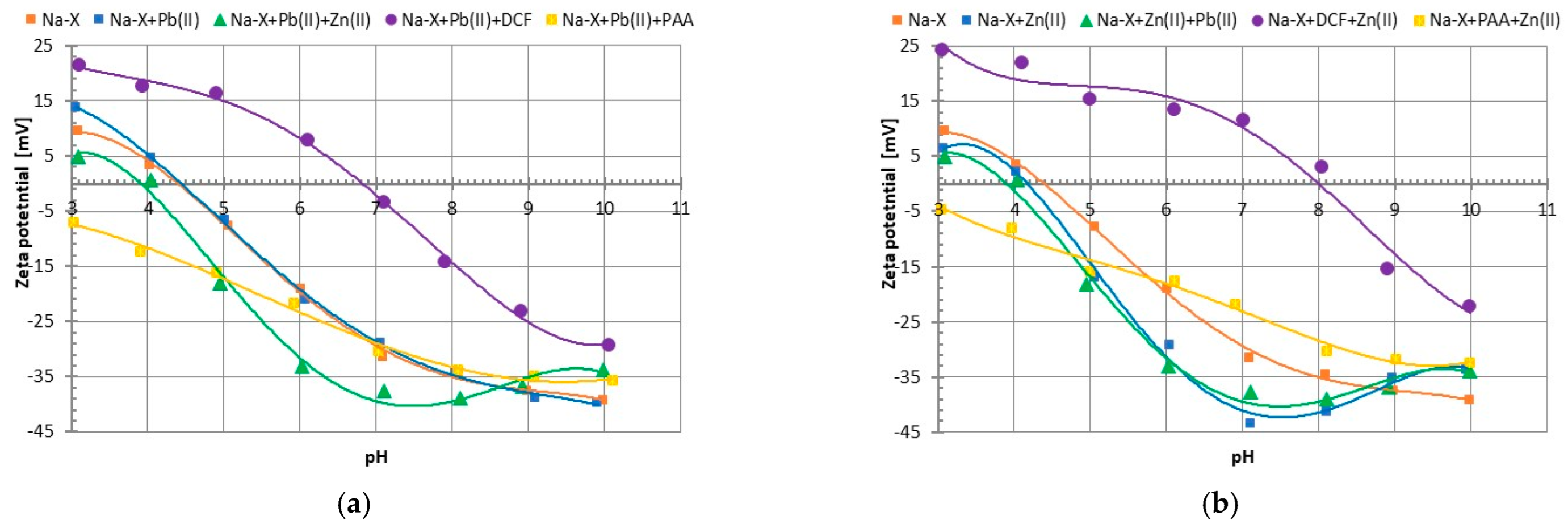

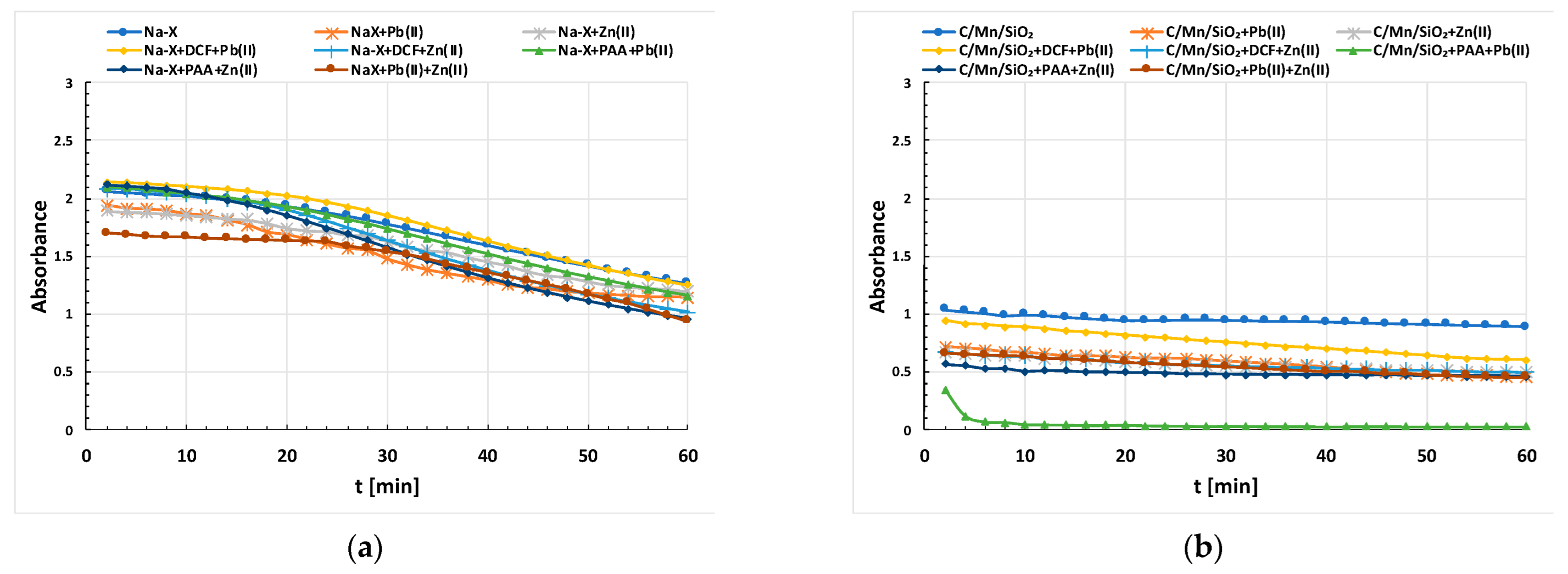
| Sample | BET Surface Area [m2/g] | Micropore Area [m2/g] | Pore Volume [cm3/g] | Micropore Volume [cm3/g] | Mean Pore Diameter [nm] |
|---|---|---|---|---|---|
| Na-X | 728 | 624 | 0.31 | 0.27 | 1.73 |
| C/Mn/SiO2 | 268 | 114 | 0.49 | 0.05 | 7.37 |
| Langmuir Model | Freundlich Model | ||||||
|---|---|---|---|---|---|---|---|
| System | qm [mg/g] | KL [dm3/mg] | R2 | n | KF [mg/g (mg/dm3)−1/nF] | R2 | |
| Pb(II) | Na-X | 676.594 | 0.227 | 0.966 | 1.625 | 0.0005 | 0.794 |
| C/Mn/SiO2 | 372.492 | 0.025 | 0.876 | 3.950 | 0.004 | 0.994 | |
| Zn(II) | Na-X | 693.289 | 4.878 | 0.997 | 2.148 | 0.0002 | 0.943 |
| C/Mn/SiO2 | 149.484 | 0.013 | 0.979 | 1.611 | 0.012 | 0.976 | |
| Material | Qm [mg/g] | Organic Additives | Reference | ||
|---|---|---|---|---|---|
| Pb(II) | Zn(II) | Pb(II)/Zn(II) | - | ||
| Zeolitic adsorbent ZCET40 | 322.58 | 69.93 | 238.10/69.93 | - | [28] |
| Zeolitic adsorbent ZDs40 | 277.78 | 61.35 | 185.1/6.35 | - | [28] |
| β-Cyclodextrin/ZrO2 | 274.4 | - | - | Bisphenol A | [29] |
| Fe-NPs | 100 | 16.74 | - | Rifampicin | [30] |
| Montmorillonite with alkyl-ammonium and complexant | 16.74 | - | p-nitrophenol | [31] | |
| EDTA and chitosan bifunctionalized magnetic bamboo biochar | 63.2 (Cd(II)) | 50.8 | - | methyl orange (305.4 mg/g) | [32] |
| Biochar-based sorbents | 19.1 | 19.2 | - | - | [33] |
| Plant-based biochars | 0.344 | 1.081 | - | - | [34] |
Disclaimer/Publisher’s Note: The statements, opinions and data contained in all publications are solely those of the individual author(s) and contributor(s) and not of MDPI and/or the editor(s). MDPI and/or the editor(s) disclaim responsibility for any injury to people or property resulting from any ideas, methods, instructions or products referred to in the content. |
© 2024 by the authors. Licensee MDPI, Basel, Switzerland. This article is an open access article distributed under the terms and conditions of the Creative Commons Attribution (CC BY) license (https://creativecommons.org/licenses/by/4.0/).
Share and Cite
Medykowska, M.; Wiśniewska, M.; Szewczuk-Karpisz, K.; Galaburda, M.; Oranska, O.; Panek, R. Green Synthesis and Efficient Adsorption: Na-X Zeolite vs. C/Mn/SiO2 Composite for Heavy Metals Removal. Materials 2024, 17, 954. https://doi.org/10.3390/ma17040954
Medykowska M, Wiśniewska M, Szewczuk-Karpisz K, Galaburda M, Oranska O, Panek R. Green Synthesis and Efficient Adsorption: Na-X Zeolite vs. C/Mn/SiO2 Composite for Heavy Metals Removal. Materials. 2024; 17(4):954. https://doi.org/10.3390/ma17040954
Chicago/Turabian StyleMedykowska, Magdalena, Małgorzata Wiśniewska, Katarzyna Szewczuk-Karpisz, Mariia Galaburda, Olena Oranska, and Rafał Panek. 2024. "Green Synthesis and Efficient Adsorption: Na-X Zeolite vs. C/Mn/SiO2 Composite for Heavy Metals Removal" Materials 17, no. 4: 954. https://doi.org/10.3390/ma17040954
APA StyleMedykowska, M., Wiśniewska, M., Szewczuk-Karpisz, K., Galaburda, M., Oranska, O., & Panek, R. (2024). Green Synthesis and Efficient Adsorption: Na-X Zeolite vs. C/Mn/SiO2 Composite for Heavy Metals Removal. Materials, 17(4), 954. https://doi.org/10.3390/ma17040954









